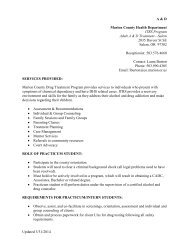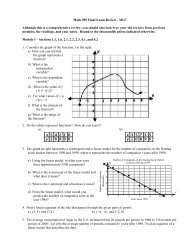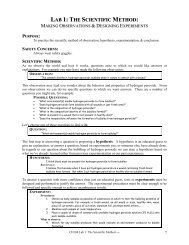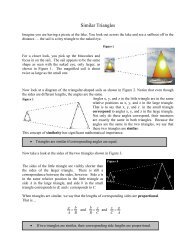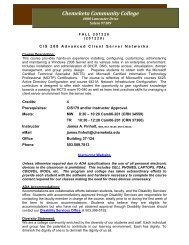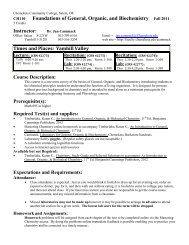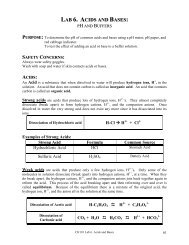9 Determination of Gas Constant - Faculty.chemeketa.edu
9 Determination of Gas Constant - Faculty.chemeketa.edu
9 Determination of Gas Constant - Faculty.chemeketa.edu
Create successful ePaper yourself
Turn your PDF publications into a flip-book with our unique Google optimized e-Paper software.
Spheres <strong>of</strong> Influence | Nanosilver: Weighing the Risks and Benefitsclothing to slow the spread <strong>of</strong> MSRA andother bacterial infections associated withclose-contact sports. 5Rosalind Volpe, executive director<strong>of</strong> the Silver Nanotechnology WorkingGroup, says nanosilver also deservesa place in common household goods.A paper by the working group explains,“Nanosilver antimicrobial treatmentscan bring a number <strong>of</strong> functionalities toconsumer articles, including longer shelflife (e.g., cosmetics) giving more safety,less waste and ultimately lower prices forconsumers; plastics that are protectedagainst the degrading action <strong>of</strong> bacteria(e.g., discoloration); and textiles that areprotected against colonization <strong>of</strong> bacteriathat can lead to odors (e.g., sportsclothing), ultimately giving greater comfortand prolonged use. Additional benefitssuch as r<strong>edu</strong>ced washing frequency at lowertemperatures can give significant water andenergy savings.” 11How Much Is Too Much?But the expansion <strong>of</strong> nanosilver intonew applications may also contributeto unique risks. Looming large amongthem is the possibility that widespreaduse <strong>of</strong> nanosilver will contribute to silverresistance in bacteria, as has happenedwith other common antibiotics includingpenicillin, 16 tetra cycline, 17 and triclosan. 18Nanosilver impregnated into consumerproducts and coatings will slowly,through laundering, be abraded from itssubstrate material at varying volumes andover varying periods <strong>of</strong> time, dependingon concentrations in the material andthe strength with which it is bonded,says Bernd Nowack <strong>of</strong> the Swiss FederalLaboratories for Materials Science andTechnology. In consumer textiles, henotes, the industry standard is for theantimicrobial effect to persist over at least50 washes, although some research suggestsnanosilver can leach from certain productswithin the first few washes. 19Critics have questioned whether it’swise to dispatch such a powerful weaponWe’ve never actually found a pathogen we couldn’t kill.That’s why silver is being used all over. It’s an incrediblysafe, very broad-spectrum antimicrobial agent. It’s naturallyoccurring, and it’s just really effective.–Keith MoellerABL Medicalagainst bacteria in everyday contexts wherebacteria pose a relatively minor concern.“It’s one thing if we’re using a little bit<strong>of</strong> nanosilver in the shoes <strong>of</strong> diabetics,”says Jaydee Hanson, policy director forthe nonpr<strong>of</strong>it International Center forTechnology Assessment. “It’s another thingif you’re putting it in all underwear, allsocks, every bed, every bed sheet. It’s ahuge, exponential increase in the amount<strong>of</strong> nanosilver we’re putting into theenvironment.”Gregory Crocetti, a Melbournebasedmicrobiologist who has worked onFriends <strong>of</strong> the Earth Australia’s nanosilvercampaign, takes a stricter position.“Nanosilver should remain in a hospitalsetting only,” he says. “Those clinical useswill be diminished by completely hystericaland frivolous uses in homes. ... Nanosilverhas a high likelihood <strong>of</strong> promoting notjust silver resistance but also antibioticresistance because <strong>of</strong> the process <strong>of</strong>co-selection.” Co-selection occurs whenbacteria challenged with one antimicrobialfind a resistance gene to it by swappingDNA with bacteria that are resistant to adifferent antimicrobial. 20Environmental ConsiderationsUp to this point there has been limiteddocumentation <strong>of</strong> silver resistance. Thesefew cases largely have been isolated inin vitro studies rather than clinical orenvironmental settings. 21,22,23,24 However,one 1975 article reported that silverresistantSalmonella typhimurium had beenisolated from a Massachusetts burn ward; 25the molecular basis for the resistance wasproposed more than 20 years later. 26Some researchers and industry groupsargue that silver and microbes havecoexisted for billions <strong>of</strong> years and thatresistance would have become evident bynow if it were a viable threat. But Crocettipoints out that silver was not historicallyused in the context <strong>of</strong> the widespreadantibiotic resistance seen today.“It is widely thought that differenttypes <strong>of</strong> antimicrobial resistance geneshave not been assembled by bacteria intosuch large collections on mobile geneticelements, particularly plasmids, untilIt’s one thing if we’re using a little bit <strong>of</strong> nanosilver inthe shoes <strong>of</strong> diabetics. It’s another thing if you’re putting itin all underwear, all socks, every bed, every bed sheet.It’s a huge, exponential increase in the amount <strong>of</strong> nanosilverwe’re putting into the environment.–Jaydee HansonInternational Center for Technology Assessmentthe last few decades,” Crocetti says. “Itis important to note here that the siloperon—the major set <strong>of</strong> silver resistancegenes—is regularly found alongside thecassettes <strong>of</strong> antibiotic resistance genesEnvironmental Health Perspectives • volume 121 | number 7 | July 2013 A 223



